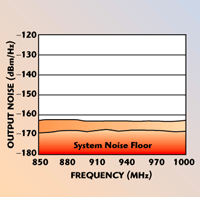
Two new surface-mount I-Q modulators/demodulators have been added to the “RFID by M/A-COM” series of products that are designed for RFID, wireless handset and base station applications. The MA4IQP900L-1291T and the MA4IQP900H-1291T HMIC I-Q modulators/demodulators are compact and highly functional devices using low and high barrier silicon Schottky diodes, respectively, and compliment the existing MA4IQP900M-1291T medium barrier silicon device. The two new modulators cover the same 850 to 960 MHz operating frequency range in a compact 6 mm square MLP surface-mount package.
The company recently introduced this line of passive MMIC-based I-Q modulators to target new transceiver/receiver wireless systems in demand of superior signal-to-noise ratio. M/A-COM’s heterolithic microwave integrated circuit (HMIC) technology, coupled with the company’s mature expertise in mixer products, was the obvious combination to provide this market solution. HMIC is a proprietary technology that allows the designer the ability to create high Q broadband passive structures on a low loss dielectric while utilizing imbedded silicon for the manufacture of Schottky diodes and low inductance ground vias. A generic schematic of an I-Q modulator comprises two mixers, a power divider and a 90° hybrid, as shown in Figure 1.

Fig. 1 Wideband insertion loss of the IMF2262 filter.
The EXP-series mixers used in the design are Schottky-based double-balanced mixers that provide excellent harmonic suppression and port isolation, two key parameters for the modulator. The remaining components all utilize the glass platform and provide the symmetry and balance required for optimum harmonic cancellation. A chart displaying the typical harmonic suppressions of these modulators is displayed in Figure 2.

Fig. 2 Modulator harmonic suppression.
Particular attention was given during the design phase to the package parasitics. Fortunately, with the operating frequency around 915 MHz and utilizing the 6 × 6 FQFP-N 28LD package, the parasitic effects were significantly reduced. Table 1 lists the overall performance of the MA4IQP900M-1291T, which is typical of the newest two versions as well.

One of the more significant characteristics of the modulators is a low output noise floor, particularly for RFID applications. Digital systems are quite different from analog systems. For example, instead of the performance slowly deteriorating with increasing noise, the quality of the received signal in digital systems rapidly deteriorates when the noise reaches the point where the receiver cannot distinguish one bit from another. A 1 dB increase in signal-to-noise ratio can cause a ten-fold increase in the probability of a bit error. In RFID system performance, this scenario can translate to the difference between a 100 percent read success to something 3 to 10 percent lower, or the ability to read a target thirty feet away versus ten. The M/A-COM series of modulators measures, on average, 8 dB better in terms of output noise floor than most of its competitors. The modulator’s typical output noise floor is displayed in Figure 3.

Fig. 3 Measured modulator output noise florr.
Applications
For RFID applications, the low barrier MA4IQP900L-1291T modulator replaces a discrete balun, quadrature hybrid and Schottky diodes with a single, monolithic device. Thus, it reduces required board space and assembly costs and improves parametric repeatability. The device operates with a low +10 dBm LO drive level and has a high input IP3 of 29 dBm.
Both the MA4IQP900L and MA4IQP900H are well suited for GSM and CDMA handset and base station applications where LO drive levels (ranging from +10 dBm for the low barrier device to +18 dBm for the high barrier device) are required. Both are 50 ? compatible and require no additional impedance matching. The modulators provide excellent linearity with higher input IP3 values (> +26 dBm). The modulator function features third- and fifth-harmonic suppressions of 45 and 89 dBc for the low barrier device, and 60 and 99 dBm for the high barrier device, thus reducing the need for additional circuit filtering.
Amplitude balance for the devices is 0.2 dB and phase imbalance is 3.0°. The new modulators are well suited for use in higher volume wireless receivers and transmitters where size and repeatability are key requirements.
Conclusion
A series of surface-mount silicon-based I-Q modulators/demodulators products has been introduced that feature high performance, reduced size and low cost. The MA4IQP900L-1291T and MA4IQP900H-1291T HMIC I-Q modulators/demodulators join the existing MA4IQP900M-1291T devices to solve the current demand for superior signal-to-noise and excellent repeatability in a small, low cost surface-mount package. Additional information may be obtained from the company’s Web site.
M/A-COM,
Lowell, MA
(800) 366-2266,
www.macom.com.
